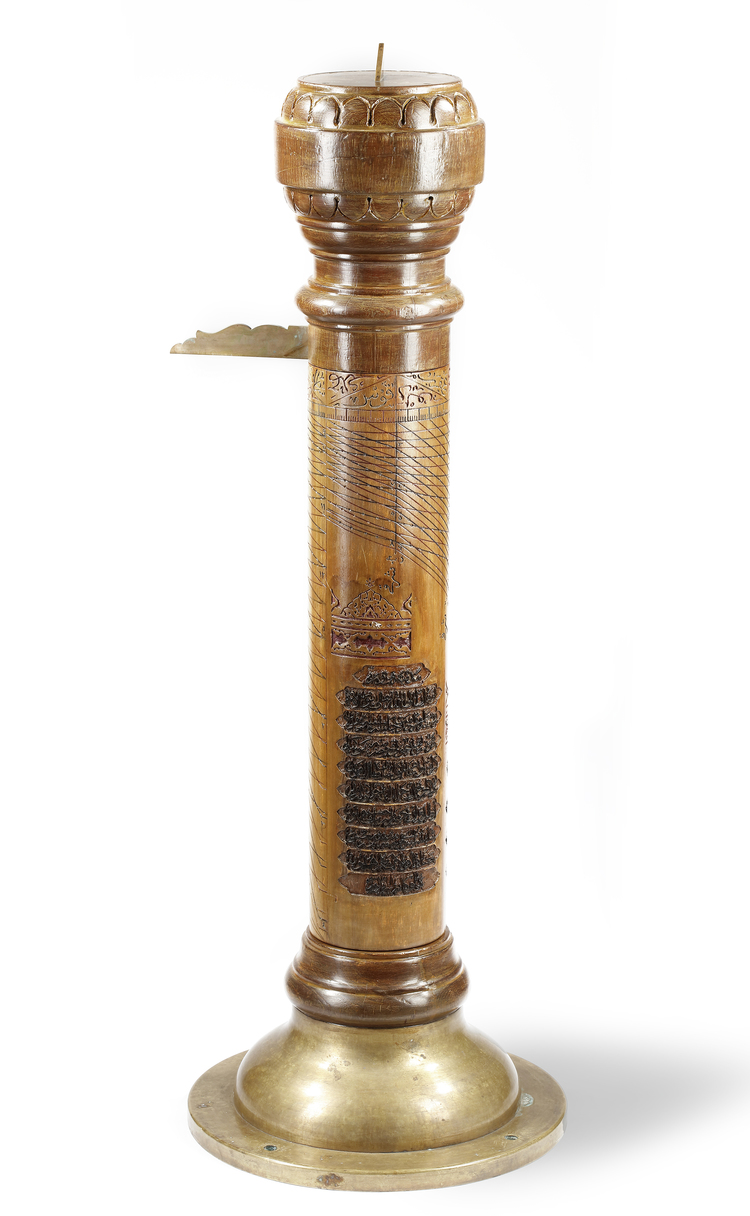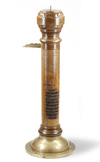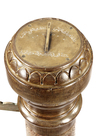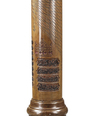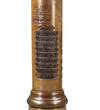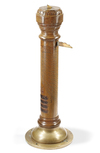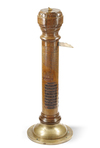AN EXCEPTIONALLY RARE AND MONUMENTAL OTTOMAN SUNDIAL SENT AS GIFT TO MEDINA, PROBABLY BY SULTAN ABDULHAMID II
Ottoman pillar shaped dual sundial made for the Holy City of Medina and sent by the Ottoman Sultan Abdülhamid by a so called “Imperial Surre” or an “Imperial Caravan”, which was sent every year from Istanbul to the Holy Cities Mecca and Medina. This is the only imperial sundial send especially to Medina that has survived.
General Anatomy and Dimensions
The sundial consists of three separate parts, which are demountable: A wooden decorative head with a brass horizontal sundial with brass gnomon and a collapsible gnomon ( for the cylindrical sundial below). A wooden cylinder with a cylindrical sundial and two inscriptions engraved A base with a lower brass and higher wooden part.
From the floor to the horizontal sundial, the pillar stands 103 cm high. The base is 37.5 cm in diameter at the widest lower part. The circumference of the middle wooden section which contains the cylinder sundial is 43 cm.
The Inscriptions
The instrument features two inscriptions in Ottoman thuluth script which are difficult to read at some points. The larger inscription is a cliché text which are, with minor differences, also used on Ottoman money pouches which were sent as gift to the two holy cities with an Imperial caravan carrying the gifts. For a very similar inscription see: (Ateş, p. 126)
Medine-i Münevvere Nevverallâhu Teâla ilâ yevm’il âhire’de Ravza-i Mutahhara hizmet-i Celilesiyle mübeccel olan Harem-i Şerif ağavat-i Hazaratına şevketlü Kerametlü, mehâbetlü, Sultan-üz-Zaman Abdülhamid Han Halladllâhu Hilâfetuhû ilâ Ahirid-deveran hazretlerinin ceyb-i Hümâyünü Şahânelerinden Ta’yini mu’tad olan Surre-i Hümayûne mülükhaneleridir.
This inscription might be translated as:
Sent from the Personal Treasure of The Illustrious, Noble and Praiseworthy Sultan of our Time, Abdülhamid Han, May God endure his Caliphate until the end of times, To the Noble Misters (Aghawat-I Hazarat), who are praised with the glorious service of the Holy Garden ( Tomb of the Prophet Muhammad) in the Enlightened city of Medina , may God the Glorious, enlighten it until the end of times, as part of yearly Imperial Surre.
This inscription shows clearly that it was sent as a gift to Medina with a so called “Imperial Surre” (Surre-i Hümayûn) caravan to the holy cities sent by the Ottoman Sultans. For the identification of the Sultan Abdulhamid in the inscription there are two choices: Abdülhamid I and Abdülhamid II. Abdülhamid I reigned between 1774-1789, Abdülhamid II between 1876-1909. In connection with the horizontal Sundial (see hereunder) it is not likely that it was sent by Sultan Abdülhamid I. But its more probable that it was sent by Sultan Abdülhamid II.
Furthermore, if one examines the elaboration of woodwork and the inscriptions wording it is highly possible that the sundial was made personally by Sultan Abdülhamid II. If so, it is quite possible that he wanted to send a personal gift to the Holy mosque in Medina and made this monumental and unique sundial with his own hands. It was probably to be to be placed near the tomb of the Prophet in Medina so that the Muslims could see and read it and pray for him.
Sultan Abdülhamid II was well-known as a master carpenter and an expert in processing wood into cupboard and fine cabinets. Sultan Abdülhamid II had also special care for the Muslim Community and therefore used the title of Caliphate to unite the worldwide Muslim community and sponsored large projects such as the railway to Medina . With various large projects, he tried to ease the long travel to and stay of Muslim pilgrims in the two holy cities.
The second shorter inscription on the pillar, is directly related to the cylindrical sundial and seems to be identical to an inscription found on the other surviving Ottoman sundials, and reads in Ottoman Turkish :
Irtifâ-i vakte âlâtdır etem
Bu eflâtunun kuburudur hem
Şems’e oldukça mukabil bu amûd
Arz-ı mâdde bildirir evkat hem.
It might be translated to English freely as follows:
A instrument to determine the time by altitude perfectly
It is also known as Plato’s cylinder
As long as this pillar is opposite to the sun
It will show time at it’s location
The reference to Plato is interesting. The reference to Plato is only found on the surviving instruments, however in the literature “Ptolemy’s cylinder” or “The Staff of Moses” is used. (Gaye Danışan, Cylinder Dials.., 2020). The reference to ancient names might not be surprising, since cylinder sundial’s were known already in antiquity and there is a surviving example. However, the surviving example has only very recently come to light and further research is needed to see if there are earlier Islamic attributions. (Arnaldi & Schaldach, A Roman Cylinder Dial, 1997).
In any case, the cylinder dial was known in the early Islamic period and medieval Islamic authors on astronomical instrumentation such as al-Marrakushi (13th century) and Najm al-Din al-Misri (14th century) give detailed instructions on how to construct the instrument. (Charette, Mathematical Instrumentation, p. 149-150). However, surviving examples are very rare and the earliest surviving Islamic instruments are Ottoman and all date from the 18th-19th century. While the other instruments are very similar in shape and make, our object is very unique in size, make and use.
The Sundials
The object features two sundials: a horizontal sundial on the head of the pillar and a cylinder sundial on the cylindrical part
The Horizontal Sundial
The horizontal sundial is made of a circular brass disk on which a triangular brass gnomon is mounted. The sundial is mounted on the wooden head of the pillar with 4 screws.
On the right of the gnomon an inscription indicates “sā’āt min ṭul’ū al-shams”, which translates as ‘Hours from Sunrise”. Below the inscription there is a circular hour scale indicating the hours running from [ 7-10], with a division per hour.
The inscription on the left indicates “sā’āt fi ghurūb el-shams” translates as “Hours until Sunset”. Below the inscription there is a circular hour scale, indicating the hours until sunset running from [ 2-5], in one hour increments.
An inscription below the gnomon indicates the date of production: “sana alfi mi’ateyn wa thalatha ashri min hijrati”. The year 1213 AH in the inscription corresponds to 1798-1799 AD. This is interesting, since it falls into the reign period of Sultan Selim III. This might indicate that the sundial was produced separately from the cylinder.
Above the word “sana” at the beginning of the inscription, the year 1211 is engraved in Arabic numerals. It is not clear why two different dates are given. Also, curiously, on the upper left of the word “sana” there is another free standing number “4” in Arabic numerals. It might indicate the month of the second date, which might be added later.
The gnomon itself is triangular and has a small triangular cutout at it’s base.
The Cylindrical Sundial
The technical properties of the cylindrical sundial are almost identical to the other, more portable Ottoman cylinder sundials.
The cylindrical sundial consists of a graph with a horizontal and vertical division. The graph encompasses the whole perimeter of the wooden cylinder and is divided into 6 sections of 30 degrees each.
The rectangular head of every section of 30 degrees is divided diagonally with a straight line, with above and below the diagonal line the name of signs. The dual “sign” captions for every section of 30 degrees is due to the fact that the graph is symmetrical and thus repeats itself over the next 6 signs in symmetry.
Below this band with 30 degree division, there is a degree scale with a division into 5 degrees and 1 degrees.
The upper surface of the wooden cylinder tube is engraved with important wind directions in Ottoman Turkish placed in the triangles of a 8 pointed star with alternating colors in black or red . Some of the inscriptions are very difficult to read. Beginning from north in clockwise direction, these are yıldız (north), poyraz (northeast), gündoğusu (east), keşişleme (southeast), kıble (south), lodos (southwest), günbatısı (west) and karayel (northwest).
Background Information
Although the history of cylindrical sundials go back to the ancient period they were still being used as late as the 18th century.
From the Ottoman period, only four surviving examples are known. They are all very small. Two of these are in the collection of the Kandilli Observatory, one in the Adler Planetarium in Chicago and one in the Institute du Monde Arabe in Paris:
Kandilli Observatory, now on display at the Rahmi Koç Museum in Istanbul ( Inv. ID 27). 18th century. Height: 30 cm., diameter: 10 cm.
Kandilli Observatory, Istanbul. (Inv. ID 77). Made by Hâfız Hüseyin in 1232 AH (1816 AD).
Institut du Monde Arabe, Paris. 18th century
Adler Planetarium, Chicago. Inv. W-209. 18th century
Literature
Ahmet Ziya Akbulut, Güneş Saatleri, Biryil Kültür Sanat Yayinlari, Istanbul, 2010
Mario Arnaldi & Karlheinz Schaldach, A Roman Cylinder Dial: Witness to a Forgotten Tradition, Journal for the History of Astronomy, xxviii (1997), p. 107-117
Ibrahim Ateş, Osmanlılar Zamanında Mekke ve Medine’ye Gönderilen Para ve Hediyeler, Vakıflar Dergisi 13 (1981), p.113-170
François Charette, Mathematical Instrumentation in Fourteenth-Century Egypt and Syria: The Illustrated Treatise of Najm al-Din al-Misri, Brill, Leiden, 2003. (p. 149 + p. 334)
Gaye Danışan, “Cylinder Dials in the History of Ottoman Astronomy, BSS Bulletin, Vol 32 (III), September 2020, p. 12 + ft. n 16
Sharma, Catalogue of Indian Astronomical Instruments, available for download at https://srsarma.in/catalogue.php
